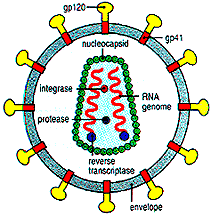|
Virus Structure
|
|
It is worth keeping in mind that the more we win, the more we drive infections to the margins of human experience, the more we clear a path for possible catastrophic infection. We'll never escape the limits of the ecosystem. We are caught in the food chain, whether we like it or not, eating and being eaten. - William McNeill, University of Chicago |
|
A virion may consist of double-stranded DNA, single-stranded DNA, double-stranded RNA, or single-stranded RNA. The DNA or RNA is protected by a protein coat called the capsid. Although viruses are diverse in their shape they share several common structural motiffs. Generally viruses adapt a protein structure that is helical, polyhedral, enveloped, or a combination. Below is an example of each of the common viral structures. |
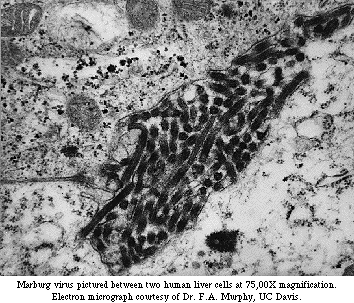 |
| An electron micrograph image of the Marburg virus, a relative of the ebola virus. Image courtesy of F. A. Murphy at U.C. Davis. |
| Helical Structure |
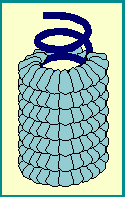 |
The tobacco mosaic virus (TMV) pictured on the left is an example of the helical structure of several kinds of virions. Virions in this category are characterized by protein subunits, named capsomeres, that form the rod-like capsid. Inside the capsid is housed the viral genome, which in the case of TMV is RNA. Together the combination of the DNA or RNA with the protein coat is called the nucleocapsid. |
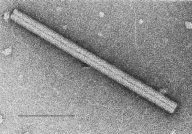 |
|
The adenovirus pictured on the right is an example of the polyhedral structure adapted by many classes of viruses. The adenovirus, which is a common cause of upper respiratory tract infections, contains a glycoprotein at the vertices of each penton. |
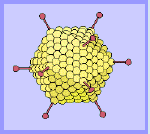 |
|
A cartoon representing the structure of the nonenveloped adenovirus. The adenovirus is made of a series of pentons that form the overall icosahedral structure. Glycoproteins, shown in red, protrude from the vertices of the penton. Image courtesy of Dr. Linda Stannard of the Department of Medical Microbiology at the University of Cape Town. |
|
A diagram of HIV, a class of enveloped viruses. Image courtesy of Ostago School of Medicine. |
HIV, the causative agent
of AIDS, is an example of a virus with an enveloped structure. Viral
envelopes are membranes that surround the nucleocapsid. The envelopes
are derived from the host cell and contain phospholipids and proteins.
Additionally, the envelope contains glycoproteins that are encoded
in the viral genome. In the case of HIV, the RNA encodes for gp120
(yellow) and gp 41 (red). Generally, there is an outer envelope
glycoprotein that binds to the host cell and a transmembrane glycoprotein
that secures the outer envelope glycoprotein to the membrane.

An electron microscopic image of HIV. Image from courtesy of Ostago School of Medicine. |
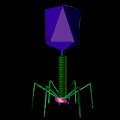 |
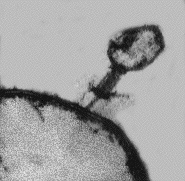 |
Phages, which are viruses that infect bacteria, are an example of a complex viral structure. Bacteriophages possess a capsid region, called the head, that is polyhedral. The head region is similar to the structure of the nonenveloped adenovirus. Attached to the head is a sheath that forms a helical rod-like structure, similar to TMV. Finally, bacteriophages contain a tail piece that anchors the virus to the bacteria. |
| A diagram of a bacteriophage showing the head in purple and the shaft and legs in green. | An image of a bacteriophage infecting a cell. Image courtesy of Evergreen State College. |
| Tutorials |
| Yellow Fever |
| Mad Cow Disease |
| Smallpox |
